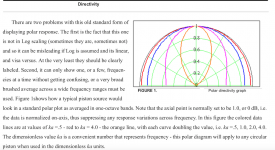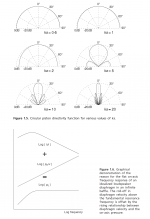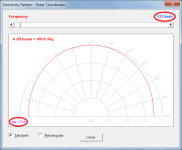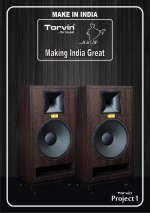what yall think about time/phase alignment vs summation at close proximity? Whoops just seen thisI would like to add to my testimony of my experience with my current system....I touched on linear phase briefly when the system was 1+8+12 and during that time (which was long ago) I had magical listening session at 1 meter...I have to consider; I'd just reached a new level of expectations...I had a 8" woofer in the system extending the image of bass/midbass source...I haven't played with linear phase since the system changed to a 4" mid. The 4" showed me the benefits of a low Ka...
2=KA for a 15" woofer is 573hz....As long as all the woofers below the tweeter have a low enough KA to support the viewing angle, at 1 meter for example, combined with phase alignment....I think summation will happen at a higher level then general consensus may appear to believe...Moving out in distance from the system may be viewed as a physical time alignment (someone would have to confirm that for me lol) but it sounds feasible considering the correction of spl via viewing angle as well as the viewing angle bring timing closer together or better said, timing offset is exaggerated with close proximity
It might be worth revisiting these systems that are claimed to have better summation with distance and check and see if KA and time/phase alignment wasn't the missing factor (unless you've already done this to confirm results)
I don't think you'd hear much if the Ka=0.5 as long as you stayed on axis with the tweeter...still path length and viewing angle is why I think a retuning of the delay and phase can optimize a system for a closer audience...Maybe an Ka too high can be adjusted for with Eq, at this new close listening position, but at the detriment of the response in the other viewing angles.As to the ka and MTM discussion, it's simple geometry the further apart the drivers are spread the more difference in path length there will be. The closer you are to the speaker the bigger those differences will be and the more likely they will be audible.
Most manufacturers are stuck having to make a choice where they think the majority of purchasers will listen and optimize for that.
5460 (1.5/19.05)=429hz
I've actually took some time and tried to estimate viewing angle based on anticipated viewing angle of the 15" at 1 meter, and referred back to Dr. Geddes charts that show the polar of Ka values. I think am out of the dog house on that one.
Last edited:
Another 2cwhat yall think about time/phase alignment vs summation at close proximity? Whoops just seen this
I don't think you'd hear much if the Ka=0.5 as long as you stayed on axis with the tweeter...still path length and viewing angle is why I think a retuning of the delay and phase can optimize a system for a closer audience...Maybe an Ka too high can be adjusted for with Eq, at this new close listening position, but at the detriment of the response in the other viewing angles.
I don't think ka correlates with minimum listening distance
(which i continue to believe is the onset of far-field math across the spectrum).
I see ka as about directivity.
Whereas minimum listening distance is about at what distance does it take for the driver's or speaker's physical size to have all frequencies emanating from its collective surface points settle into a phase coherent propagation.
ka is relative size vs wavelength.
Whereas minimum distance /onset of far-field, is more about size only.
I think that minimum listening distance is a mix of view angle (Directivity), path length, optimization of delay and phase ....and fr at listening position unless ka is so low for the mid that its fr is uniform at the close viewing angle...I forget exactly how but of course ctc comes into play
The test would be to set a listening session within very close range, as close as the systems ka allows, linearize phase and delay, start testing. Compare that with the other idea of 3x baffle length.
The test would be to set a listening session within very close range, as close as the systems ka allows, linearize phase and delay, start testing. Compare that with the other idea of 3x baffle length.
When you guys say KA, what is A? It can be many things - like source spacing or driver radius. Each acts differently.
Historically "a" is the source radius and "b" is the source spacing.
I've been using it like this...ka is a dimensionless number that equals circumference (in mm, m, in, ft, etc) divided by wavelength (in the same unit of measure).
I hope camplo has been too....
I think that minimum listening distance is a mix of view angle (Directivity), path length, optimization of delay and phase ....and fr at listening position unless ka is so low for the mid that its fr is uniform at the close viewing angle...I forget exactly how but of course ctc comes into play
The test would be to set a listening session within very close range, as close as the systems ka allows, linearize phase and delay, start testing. Compare that with the other idea of 3x baffle length.
I see it as simpler than juggling all those variables. They may all be in play, but it seems too academic to do anything with (for me).
Not sure what you mean by "as close as the systems Ka allows" unless your talking about off-axis measurements. Cause on-axis, Ka doesn't matter.
I've made comparisons tuning at different distances hundreds, thousands of times, on CD/horns over 12", synergies, MTMs, and others.
But for an example, let's just use a single driver. (outdoors)
a. tune on-axis at close range (1-1.5m), to achieve near perfect mag, phase, and impulse. Then measure slightly off-axis set at same close distance.
b. tune on-axis at >3m, again achieving near perfect mag, phase, and impulse. Then measure at the same off-axis set of angles made close in.
The variation in polars will be dramatically greater for the closer 1-1.5m set.
Also when trying to repeat the process for verification, it is super critical for the 1-1.5m mic placement to be an exact match with the previous mic placement.
It's not nearly as critical for the mic to be an exact match at 3+m.
Again, keep off-axis angles the same close and far, so it's apples to apples, and so that the increased variance close in has to be due to being too close in.
It's easy to see/measure.
All this is just common sense really, i think. In the near-field, a single cone driver acts as multiple sources. It has to be messier, and have a harder time coupling with other drivers/horns.
Last edited:
We are in agreement about the drivers acting more like individual drivers at a very close range...again I say that alignment of delay and phase should null this affect since its the exaggeration of path lengths at fault for the most part.
I only know Ka from the pages on directivity written by Geddes. So in my mind I see the chart available there, where Ka=0.5 (iirc) is the level at which dispersion covers a full 180 degrees (or at least very close to it)...
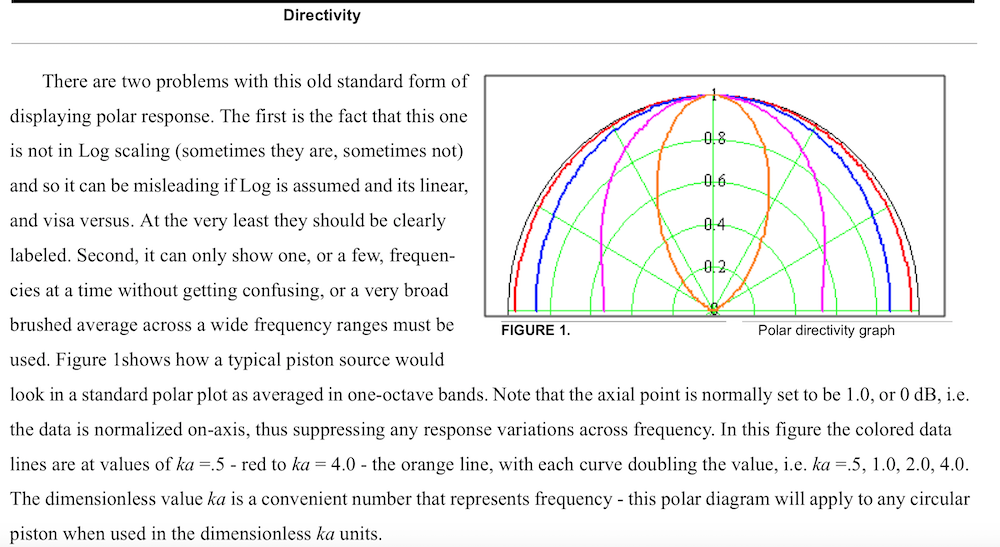
For the example of the single driver, if we limit bandwidth to limit Ka to 0.5 or lower.... it will not measure dramatically different on or off axis regardless if 1 or 3 meters...this is why Ka is important to the equation, it allows uniform eqing that is uniform throughout the polar, when all other woofers located off axis of the tweeter, have a low enough ka that the listener is still in the (near) 0db transfer function area...keeping the dead on axis performance of these other drivers, near true, to the off axis, that the listener is at, while close proximity & dead on axis with the tweeter...I consider dead on axis with tweeter to be the 0 axis of my design...or any design unless otherwise specified.
In our multi-way example, the ka of the midrange (or any surrounding drivers) matters, while the tweeter represents the 0 axis. From there it should be self explanatory. I've only neglected the affects of baffle size on directivity at this point...oh and ctc spacing but this not an issue dead on axis with tweeter.
I only know Ka from the pages on directivity written by Geddes. So in my mind I see the chart available there, where Ka=0.5 (iirc) is the level at which dispersion covers a full 180 degrees (or at least very close to it)...
For the example of the single driver, if we limit bandwidth to limit Ka to 0.5 or lower.... it will not measure dramatically different on or off axis regardless if 1 or 3 meters...this is why Ka is important to the equation, it allows uniform eqing that is uniform throughout the polar, when all other woofers located off axis of the tweeter, have a low enough ka that the listener is still in the (near) 0db transfer function area...keeping the dead on axis performance of these other drivers, near true, to the off axis, that the listener is at, while close proximity & dead on axis with the tweeter...I consider dead on axis with tweeter to be the 0 axis of my design...or any design unless otherwise specified.
In our multi-way example, the ka of the midrange (or any surrounding drivers) matters, while the tweeter represents the 0 axis. From there it should be self explanatory. I've only neglected the affects of baffle size on directivity at this point...oh and ctc spacing but this not an issue dead on axis with tweeter.
Attachments
Last edited:
Figure 1.6 shows a graphical demonstration of where the ‘flat’ response comes from. In practice, this seemingly perfect on-axis response is compromised by non-piston diaphragm behaviour and voice-coil inductance etc. Even with a perfect, rigid, piston for a diaphragm and a zero-inductance voice-coil, the flat on-axis response has limited use; the piston directivity function in Fig. 1.5 tells us that as frequency increases, so the radiation becomes more directional and is effectively ‘beamed’ tighter along the axis.
Attachments
For the example of the single driver, if we limit bandwidth to limit Ka to 0.5 or lower.... it will not measure dramatically different on or off axis regardless if 1 or 3 meters...this is why Ka is important to the equation, it allows uniform eqing that is uniform throughout the polar,
Ka=2 for a 15" driver is 573hz....
2149.6hz for a 4" driver...
Limiting the driver to only being used when it is completely omnidirectional is not practical in all cases and not desirable always either.
The 18" should have very low inductance for not to have a different distortion each stroke of membrane on large displacement.
Doesn't this apply to all all drivers that reproduce lows and mids at the same time ?
Regards
Charles
For a plane circular piston source, ka is the wave-number k = 2 * Pi * f / c multiplied by piston radius a.
Using camplo's example of a 15" driver at 573 Hz:
ka = 2 * Pi * 573 / 34400 * (15 / 2 * 2.54) = 2.0 (to one decimal place)
Yes sir, Seems like everyone has same definition and math for once
I personally like the Ka math expressed as circumference (in mm, m, in, ft, etc) divided by wavelength (in the same unit of measure)
because it allows me to easily remember and picture the relationship between piston size, wavelengths, and coverage angles.
For the example of the single driver, if we limit bandwidth to limit Ka to 0.5 or lower.... it will not measure dramatically different on or off axis regardless if 1 or 3 meters..
I don't think this is correct. Even with an omni-like Ka of 0.5, it will measure very different if the mic-to-driver distance is less than several multiples of the driver diameter. At the same off-axis angles.
It's easy to verify...just take any 18" driver and give it a go.
On axis...centered on the dustcap will have the least variation with distance, close to far.
But move a little off-axis and watch what happens close to far. (Real time dual channel transfers make this easy to see.)
The thing is, you certainly can align phase and mag inside the near-field to any specific spot, either for a single driver or multiple drivers.
But, any measurements and acoustic summations away from that near-field spot, greatly amplify the variations than encountered in the far-field measured against the same reference axis.
(for definition/clarity sake: i'm using "near-field" or "close", as less than several piston diameters. And "far-field" of course, as greater than than that distance)
(for definition/clarity sake: i'm using "near-field" or "close", as less than several piston diameters. And "far-field" of course, as greater than than that distance)
How do you account for the fact that the near field changes with frequency - very short at LFs getting ever greater for high frequencies?
Doesn't this apply to all all drivers that reproduce lows and mids at the same time ?
Regards
Charles
This is only true to the extent that the inductance changes with coil position. If it does not, or is small, then no distortion takes place.
I'm not scared to have an 18" playing to 250hz ( with steep slope lp) but higher...??
The 18" should have very low inductance for not to have a different distortion each stroke of membrane on large displacement.
See above, and how high a woofer can be used is highly specific to the driver. It was not easy to find a 15" that works up to 800-900 Hz, but it is possible.
Using a driver only when it is omni is not something that I would ever do. I want the drivers directivity to narrow to a higher DI to match the waveguide.
- Home
- Loudspeakers
- Multi-Way
- Is it possible to cover the whole spectrum, high SPL, low distortion with a 2-way?
